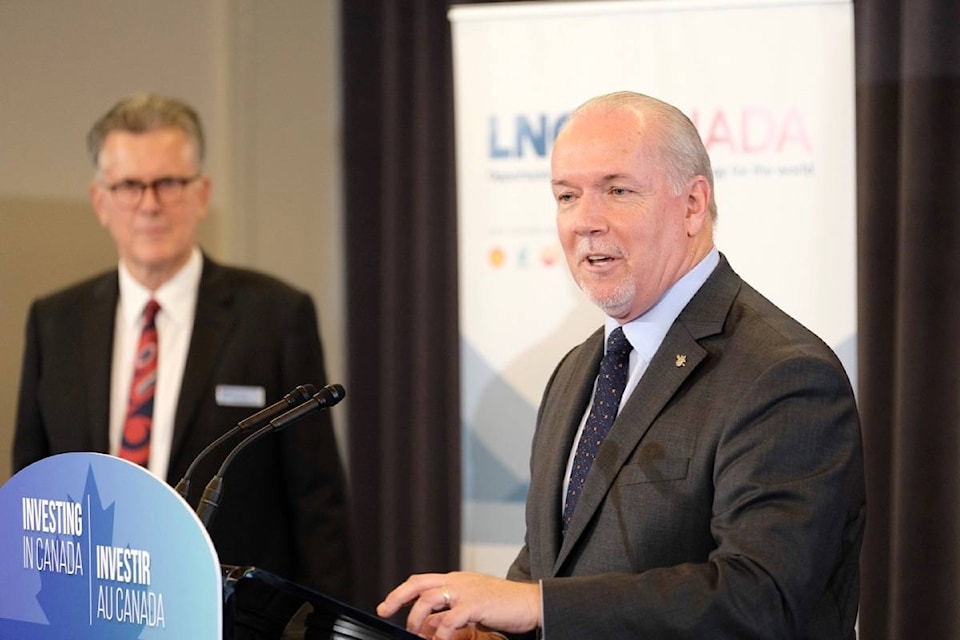Premier John Horgan spoke with Black Press legislature reporter Tuesday, after joining Prime Minister Justin Trudeau and LNG Canada partners to announce their investment of $40 billion in a pipeline and natural gas export terminal at Kitimat.
TF: You’ve got big environmental challenges still to come, starting with a pipeline over the Rocky Mountains, and there is still a protest camp on the route. What’s ahead there?
JH: LNG Canada has been working with elected councils from Fort St. John right through to Haisla, and have the support of all of those nations. There are hereditary groups, particularly in Wet’suwet’en territory, who are not yet there. I made a trip to Wet’suwet’en territory in the past couple of weeks, not to negotiate, just to hear the concerns of the people in the region. And I’m confident that with some more hard work we can get to a place where the benefits of this activity will outweigh the negatives that hereditary groups are looking at today.
TF: We heard this morning that there is dredging already underway at the head of Douglas Channel, and there will be LNG tankers that won’t spend much time on the B.C. coast on their way to Asian ports. Do you expect the kind of organized opposition that we’ve seen with other energy projects?
JH: I don’t think so, for a couple of reasons. Natural gas, of course, is quite different from diluted bitumen. And as you said, the amount of time spent in and around sensitive areas is less, and again, we have almost unanimity through Indigenous communities right from wellhead to waterline. That means tremendous opportunity for economic growth, cultural and social reconciliation.
There are so many benefits that flow from a private sector investment of this magnitude. As the Prime Minister said, it’s the single largest private sector investment in Canadian history. That is a powerful statement and that means that people’s lives will better. We’ll do our best to protect our coast. We’ll do our best to fit within the climate plan that Environment Minister George Heyman is developing as I speak.
And at the end of the day, this is going to be looked back on as one of those pivotal moments in northern B.C. history, where we set down a foundation for economic and social development.
TF: Green leader Andrew Weaver questioned Heyman in the legislature this morning, asking why your party supports this project but opposed the Petronas proposal for Prince Rupert, specifically citing the greenhouse gas emissions there.
JH: My concern in opposition about the Pacific Northwest LNG proposal was the siting. Mr. Weaver may have found a quotation about greenhouse gases, but my issue was that Lelu Island was a greenfield site with potential impacts on salmon, and no buy-in from the traditional territory rights holders, the particular clan of the Lax Kw’alaams.
Mr. Heyman and others may have talked about greenhouse gas emissions, but we’re in a position now put in place a plan. We’ve set targets, and we’re going to legislate the plan this fall. And that’s where Mr. Heyman and Mr. Weaver and others will be able to refine what sectors need to have their belts tightened more quickly because of this investment.
We have to deal with transportation emissions, housing emissions, and the industrial side where we’re going to see an increase because of this project, also has to tighten its belt. That means electrification of the gas fields to reduce upstream impacts. There are a whole bunch of things we can and will do, and we’re better able to do it because there’s $23 billion in new revenues coming as a result of this project.
TF: You campaigned on a promise for a scientific review of gas extraction in B.C. and water effects. What’s the status of that?
JH: It’s been underway since March. The panel has met 40 times with academics, with Indigenous people, with communities, with industry, and we’re expecting their report to be tabled with Energy Minister Michelle Mungall either late this year or early next year.
That’s a commitment we fulfilled at the same time as we announced the framework for investment in natural gas. So I’m confident that best practices in B.C. will be demonstrated.
You know, Tom, if you go on the interwebs and you google ‘taps on fire’ you’ll get a lot of examples of gases that are coming from places they shouldn’t come from. I want to make sure that when it comes to the extraction of gas in B.C. we’re using best practices and we’re mindful of the impacts on water, on Indigenous communities and on human health.
TF: Do you expect B.C. Liberal support for your tax changes that helped close the deal for LNG Canada?
JH: The framework that we put together last March was fairly critical, I’m told by the investors, to getting us past the final investment decision. That is a result of many decades of work by many people to get us to this point. And I’m hopeful that MLAs, Liberals and Greens and New Democrats will look at the benefits of job creation, the private sector investment, the hope that this provides in the North, from wellhead to waterline, Indigenous communities, that they will support the initiatives.
It will mean at the end of the day about $23 billion revenue to the Crown that we can put into schools and hospitals, and that’s what everyone wants to see.
@tomfletcherbc
tfletcher@blackpress.ca
Like us on Facebook and follow us on Twitter.
